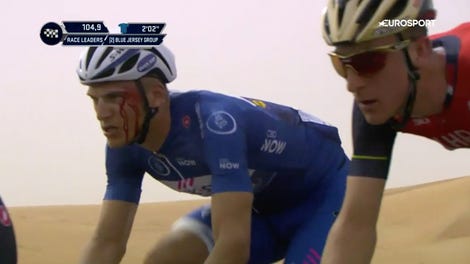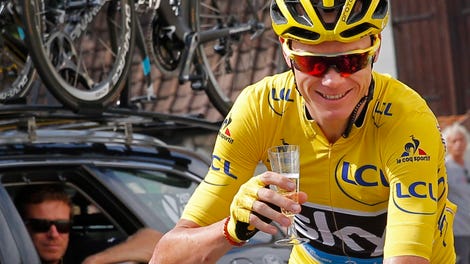
The professional cycling peloton is currently wrapping up its preseason at the Abu Dhabi Tour, the last of the Middle East races. The first cobbled classic of the season takes place this weekend, but for now, the best sprinters in the world are enjoying the warm temperatures and flat roads of the United Arab Emirates one last time.
Marcel Kittel dominated the Dubai Tour, but British superstar Mark Cavendish took Stage 1 this morning and Kittel crashed out at high speed inside of the last kilometer. One of the many riders who got tangled up in the collision was Team Sky debutante Owain Doull, who crossed the line with Kittel a few minutes after the front of the pack had gone through, dejected and battered. Doull’s butt and back were scraped up, but after he finished, he spoke to reporters and revealed that his foot got sliced up in the crash. As you can see, his shoe got a neat gouge taken out of it and one of his toes took a cut from, well, something.
Doull received treatment for the road rash, and he claimed that Kittel’s bike had cut his shoe to pieces. Kittel is the only rider at the Abu Dhabi Tour with disc brakes on his bike, brakes which Doull says sliced into him. Disc brakes have slowly been pushed into the peloton primarily at the behest of bike manufacturers, and they offer advantages over pivot brakes, although the benefits are slight and the risk of injury is much higher when every bike in the peloton is outfitted with a pair of whirling knives. Despite the injury he took, Doull said that he was lucky he didn’t lose a toe or take a red-hot disc brake to the leg:
“My shoe was cut to pieces. That’s definitely a disc brake that has done that,” said Doull.
“It’s gone straight through the shoe into my foot. It’s lucky that’s not my leg to be honest. If anything I’ve come off lucky there, if that’d been my leg it would have cut straight through it, for sure. You’ve seen my shoe – it’s gone straight through that.”
[…]
“In my opinion unless there are covers on those things they’re pretty lethal.”
This is reminiscent of a gnarly knee injury that Fran Ventoso suffered in last year’s Paris-Roubaix, where he claims he fell on a disc brake and got his knee all sliced up (an investigation later ruled that it was likely a chainring). Riders grumbled about the slow introduction of disc brakes into the peloton then, and shortly after Doull posted a picture of his shoe today, a bunch of pro riders spoke up about the crash and voiced their opposition to the brakes once again.
Luke Rowe also had a good take.
However, as many later pointed out, the video footage is inconclusive. Doull fell right near an upturned rusty barrier foot and there is an orange-ish stain on his shoe. VeloNews gave the crash footage the Zapruder treatment and found that the video suggests that Doull didn’t get carved up by Kittel’s brake. Doull’s left foot was cut, and he was to the left of Kittel when he caused the crash, so his foot would have needed to go under his bike and get in the way of Kittel’s bike for the disc to have caused the cut. Furthermore, certain disc brakes aren’t even sharp enough to cut through a cycling shoe.
That said, the barrier might not have caused such a clean cut without leaving any bruising. The crash did take place at very high speed and even after painstaking analyses of the wreckage, it’s still impossible to determine what happened beyond a shadow of a doubt.
Regardless, the UCI said that they will be investigating the crash. Cycling’s governing body has repeatedly clashed with the professional cyclists’ union (CPA) over the use of disc brakes, and the CPA sent a formal letter to the UCI two weeks ago asking for the slow implementation of disc brakes to be suspended until a full trial could be held. Despite the confusing evidence put forth in this case, the riders seem to be taking Doull’s side en masse and are putting pressure on the UCI to re-evaluate the trial period. Here’s what the UCI said:
“The trial of disc brakes in road events is closely monitored and formally reviewed on a regular basis. We are gathering evidence on this specific incident and will review all elements in our possession in due course.”
That’s not a very strong statement, and if they find that Doull actually got gouged by a barrier, they won’t have much impetus to slow the integration of discs. Whether or not Doull and Ventoso were actually cut up by discs, the danger that they pose is still unclear. Cycling has continually adapted to new technologies throughout the course of its history, and while riders have historically been resistant to change, the amount of prominent riders speaking up about disc brakes is indicative of a clear lack of trust between the UCI and the peloton.






